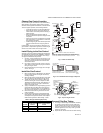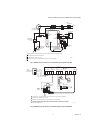
VR8304 INTERMITTENT PILOT COMBINATION GAS CONTROL
69-0625—03 6
Perform Gas Leak Test
WARNING
Fire or explosion hazard. Can cause property
damage, severe injury, or death.
Check for gas leaks with a rich soap and water
solution any time work is done on a gas
control.
Gas leak test
1. Paint all pipe connections upstream of the gas con-
trol with a rich soap and water solution. Bubbles
indicate a gas leak.
2.
If a gas leak is detected, tighten the pipe connection.
3. Stand clear while lighting the main burner to prevent
injury caused from hidden gas leaks, which could
cause flashback in the appliance vestibule. Light
the main burner.
4. With the main burner in operation, paint all pipe
joints (including adapters) and the gas control inlet
and outlet with a rich soap and water solution.
5. If another gas leak is detected, tighten adapter
screws, joints, and pipe connections.
6. Replace the part if the gas leak cannot be stopped.
Adjust the Pilot Burner Flame
The pilot flame should envelop 3/8 to 1/2 in. (10-13 mm) of
the igniter sensor tip. See Fig. 9. To adjust the pilot flame:
1. Remove the pilot adjustment cover screw. Refer to
Fig. 4.
2. Turn the inner adjustment screw clockwise to
decrease or counterclockwise to increase the
pilot flame.
3. Always replace the cover screw after adjustment
and tighten firmly to ensure proper operation.
Fig. 9. Proper flame adjustment.
Check and Adjust Gas Input to
Main Burner
CAUTION
1.
Do not exceed the input rating stamped on the
appliance nameplate or the manufacturer’s
recommended burner orifice pressure for the size of
orifice(s) used. Ensure the main burner primary air
supply is properly adjusted for complete combustion
(refer to the appliance manufacturer’s instructions).
2. IF CHECKING GAS INPUT BY CLOCKING THE
GAS METER:
• Ensure that the only gas flow through the meter
is that of the appliance being tested.
• Ensure that other appliances are turned off and
that their pilot burners are extinguished (or deduct
their gas consumptions from the meter reading).
• Convert the flow rate to Btuh as described in the
Gas Controls Handbook (form number 70-2602)
and compare to the Btuh input rating on the
appliance nameplate.
3. IF CHECKING GAS INPUT WITH A MANOMETER
(PRESSURE GAUGE):
• Ensure the gas control knob is in the PILOT
position before removing the outlet pressure tap
plug to connect the manometer.
• Turn the gas control knob back to PILOT when
removing the manometer and replacing the
outlet pressure tap plug.
• Shut off the gas supply at the appliance service
valve or, for LP gas, at the gas tank before
removing the outlet pressure tap plug and before
disconnecting the manometer and replacing the
outlet pressure tap plug.
• Perform the gas leak test at the inlet pressure
tap plug.
Standard-opening and slow-opening
pressure regulator
1. The gas control outlet pressure should match the
manifold pressure listed on the appliance name-
plate.
2. With the main burner operating, check the gas con-
trol flow rate using the meter docking method or
check the gas pressure using a manometer con-
nected to the gas control outlet pressure tap. Refer
to Fig. 4.
3.
If necessary, adjust the pressure regulator to match the
appliance rating. Refer to Table 5 or 6 for the factory
set nominal outlet pressures and adjustment ranges.
a. Remove the pressure regulator adjustment cap
and screw.
b. b.Using a screwdriver, turn the inner adjustment
screw clockwise to increase, or counter-
clockwise to decrease, the main burner gas
pressure.
c. Always replace the cap screw and tighten firmly
to ensure proper operation.
4.
If the desired outlet gas pressure or gas flow rate can-
not be achieved by adjusting the gas control, check
the gas control inlet pressure using a manometer at
the inlet pressure tap. If the inlet pressure is in the nor-
mal range (refer to Table 6 or 7), replace the gas con-
trol. Otherwise take the necessary steps to provide
proper gas pressure to the gas control.
Step-opening pressure regulator
1.
The gas control outlet pressure should match the
manifold pressure listed on the appliance nameplate.
2. With the main burner operating, check gas control
flow rate using the meter clocking method or check
the gas pressure using a manometer connected to
the gas control outlet pressure tap. Refer to Fig. 4.
3.
If necessary, adjust the pressure regulator to match
the appliance rating. Refer to Table 5 or 6 for factory-
set nominal outlet pressures and adjustment ranges.
a. Remove pressure regulator adjustment cap
screw.
b. Using a screwdriver, turn the inner adjustment
screw clockwise to increase or counter-
clockwise to decrease the main burner gas
pressure.
c. Always replace the cap screw and tighten firmly
to ensure proper operation.
4.
If the desired outlet pressure or flow rate cannot be
achieved by adjusting the gas control, check the inlet
pressure using a manometer at inlet pressure tap or
upstream of the gas control. If the inlet pressure is in the
normal range (refer to Table 6 or 7), replace the existing
gas control. Otherwise, take the necessary steps to
provide proper gas pressure to the gas control.
PROPER FLAME
ADJUSTMENT
IGNITER-
SENSOR
M3080A
3/8 TO 1/2 INCH
(10 TO 13 mm)










